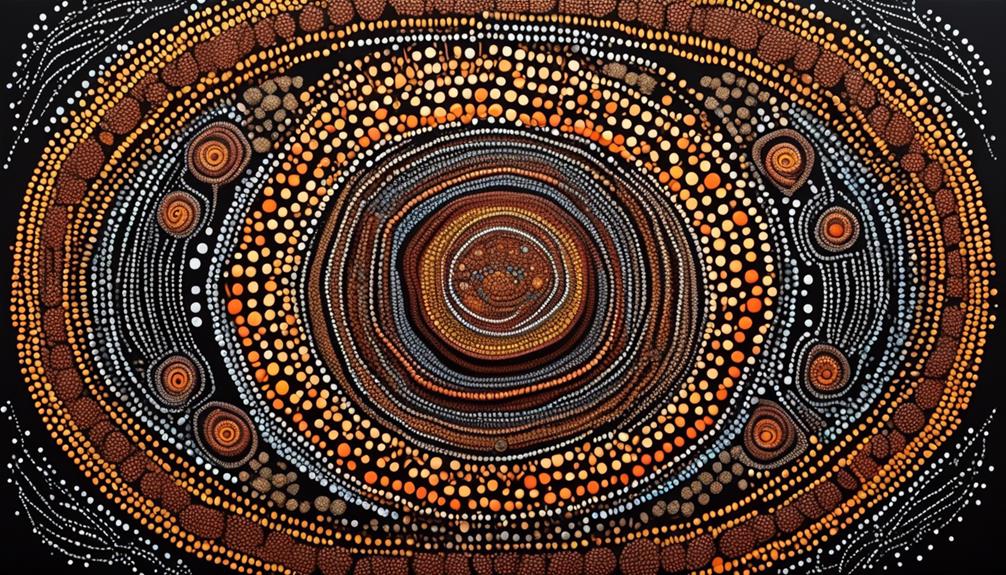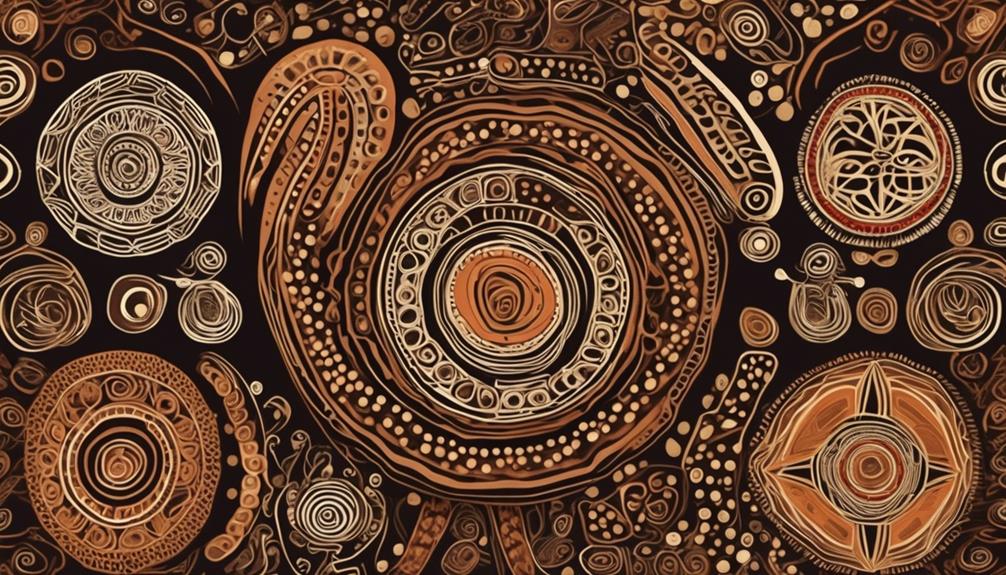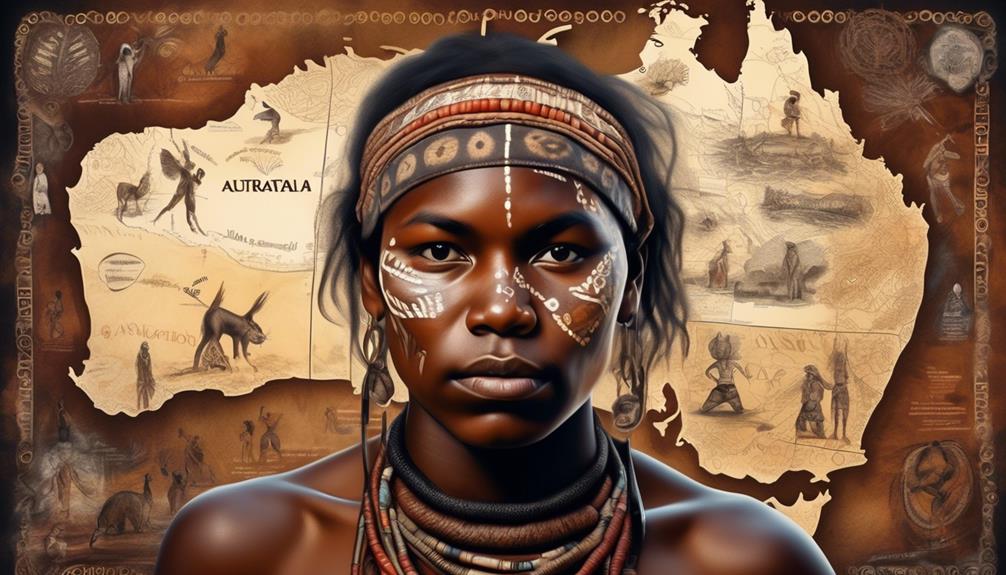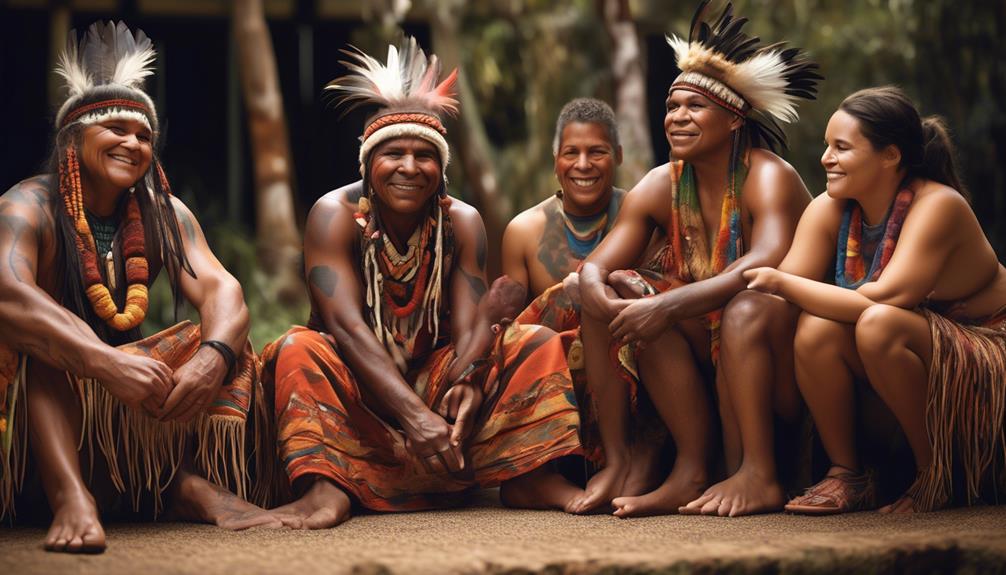You may not be aware that the use of dots in Aboriginal art goes beyond just visual appeal. These intricate dot patterns carry significant meaning, representing the cultural, spiritual, and historical aspects of Aboriginal life.
The answer lies in the rich storytelling tradition, symbolism, and connection to the land that will provide a fascinating insight into this unique artistic practice. The use of dots in Aboriginal art is not arbitrary, but rather a deliberate choice made by artists to convey specific meanings and messages.
Aboriginal art is deeply rooted in storytelling, with each dot representing a part of a larger narrative. The dots are arranged in intricate patterns, often depicting Dreamtime stories, creation myths, or important events in Aboriginal history. The dots serve as a visual language, allowing artists to communicate complex stories and concepts in a compact and symbolic way.
Symbolism is another key aspect of the use of dots in Aboriginal art. Different colors and arrangements of dots can carry specific meanings. For example, white dots may represent stars or ancestral spirits, while red dots may symbolize the earth or bloodlines. By carefully selecting and arranging dots, artists can convey layers of meaning and evoke a sense of connection to their cultural heritage.
Lastly, the use of dots in Aboriginal art is closely tied to the connection to the land. Aboriginal peoples have a profound spiritual and cultural relationship with the land they inhabit. The dots in their artwork can represent sacred sites, waterholes, or ancestral tracks that crisscross the landscape. Through the use of dots, artists can depict their deep connection to the land and their role as custodians of their ancestral territories.
In conclusion, the use of dots in Aboriginal art goes beyond mere decoration. It is a deliberate and meaningful artistic practice that embodies storytelling, symbolism, and a profound connection to the land. By understanding the significance of these dots, we can gain a deeper appreciation for the rich cultural heritage and artistic traditions of Aboriginal peoples.
Key Takeaways
- Dot painting is a traditional form of storytelling and cultural expression among Aboriginal artists.
- Dots in Aboriginal art often represent sacred sites, dreamtime stories, and the connection between the physical and spiritual worlds.
- The use of dots in Aboriginal art serves as a visual language that communicates cultural storytelling.
- The use of dots in Aboriginal art is deeply connected to the spiritual beliefs and ancestral stories of Indigenous Australian people.
Historical Significance of Dot Painting
The historical significance of dot painting lies in its integral role as a form of storytelling and cultural expression among Aboriginal artists. This unique form of Aboriginal art dates back thousands of years and has been used to convey sacred stories and traditions.
The technique involves creating intricate patterns using small, carefully placed dots. These patterns often represent aspects of the Dreamtime, the Aboriginal understanding of the world's creation and spiritual beliefs. The use of dots allows artists to encode layers of meaning into their work, with each dot holding significance within the larger narrative.
This artistic technique serves as a way for artists to connect with their cultural heritage and pass down traditional knowledge to future generations. Moreover, dot painting is a visual representation of the deep connection Aboriginal people have with their land, as many of the stories depicted in the art are tied to specific geographic locations.
Through this technique, Aboriginal artists preserve and share their cultural identity, making dot painting a vital and enduring form of artistic expression.
Symbolism and Meaning of Dots
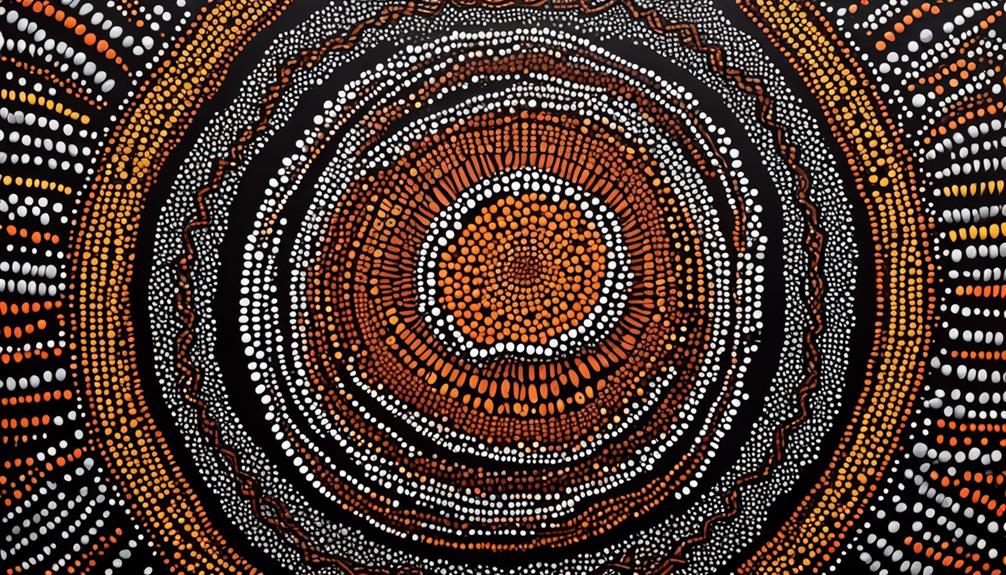
Exploring the symbolism and meaning of dots in Aboriginal dot painting reveals the intricate layers of cultural significance embedded within this traditional artistic technique. The use of dots in Aboriginal art goes beyond mere aesthetic appeal; it's a form of cultural expression deeply rooted in tradition and spirituality.
Understanding the symbolism of these dots provides insight into the rich tapestry of Aboriginal culture and history.
Spiritual Connections: Dots in Aboriginal art often represent sacred sites, dreamtime stories, and the connection between the physical and spiritual worlds.
Storytelling: Each dot carries meaning and can be read as part of a larger narrative, depicting ancestral traditions, hunting practices, and environmental knowledge.
Cultural Identity: The arrangement and style of the dots can signify specific clan or kinship ties, acting as a visual language that communicates cultural identity.
Artistic Technique: The meticulous application of dots reflects a deep understanding of nature and the environment, as well as the artist's skill in utilizing traditional materials and methods to create meaningful compositions.
The use of dots in Aboriginal art transcends mere decoration, serving as a profound expression of cultural heritage and spiritual beliefs.
Connection to Cultural Stories and Traditions
Immersing yourself in the intricate patterns of dots in Aboriginal art unveils a profound connection to cultural stories and traditions, enriching your understanding of the deep-rooted significance embedded within each artwork.
The use of dots in Aboriginal art serves as a visual language that communicates cultural storytelling, often depicting ancestral narratives, creation stories, and the connection to the land. Through these artistic techniques, Aboriginal artists preserve and pass on their cultural heritage, ensuring that the traditions and histories aren't lost but celebrated and remembered.
The dots themselves can represent various elements such as sacred sites, waterholes, or the stars in the night sky, each carrying its own significance in the storytelling process. This method of encoding cultural knowledge within the artwork serves as a way of maintaining and transmitting their traditions to future generations.
Spiritual and Ancestral Relevance
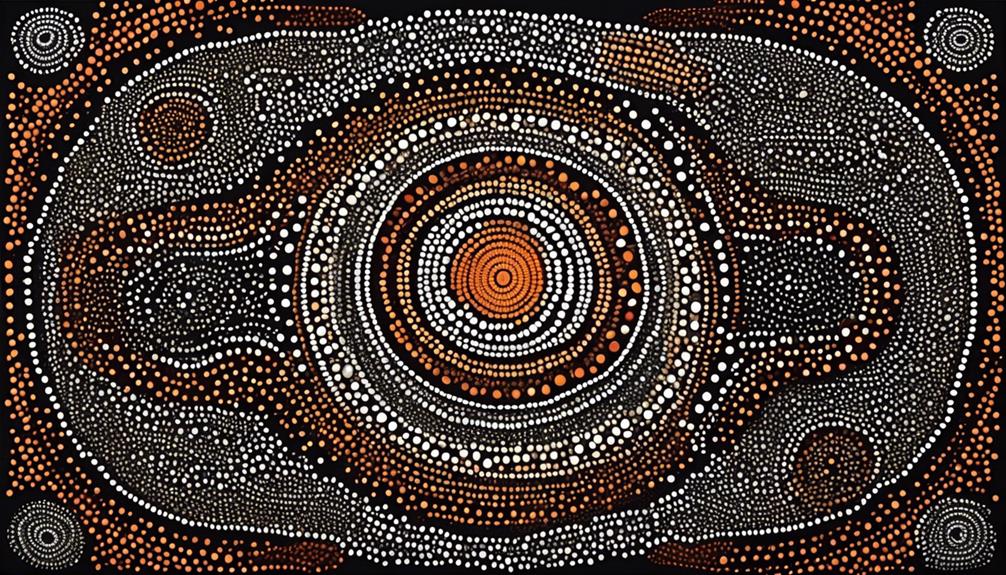
Engaging with the intricate patterns of dots in Aboriginal art reveals a profound spiritual and ancestral relevance, enriching your understanding of the cultural significance embedded within each artwork.
The use of dots in Aboriginal art is deeply connected to the spiritual beliefs and ancestral stories of the Indigenous Australian people. Here's why the spiritual and ancestral relevance of this artistic technique is so significant:
- Spiritual Connection: The meticulous process of creating dot paintings is a spiritual act for Aboriginal artists, symbolizing their connection to the land, ancestors, and Dreamtime stories.
- Storytelling Through Symbols: Each dot carries spiritual meanings and represents elements of the Dreaming, serving as a visual language to communicate ancestral stories and traditions.
- Honoring Ancestors: By using dots, artists pay homage to their ancestors and the knowledge passed down through generations, fostering a deep spiritual connection to their heritage.
- Cultural Resilience: The continuation of dot painting traditions reflects the resilience of Aboriginal cultural practices, maintaining a strong spiritual connection to their land and identity despite historical adversity.
Understanding the spiritual and ancestral relevance of dots in Aboriginal art provides a profound insight into the enduring cultural significance and deep-rooted spirituality of Indigenous Australian communities.
Influence of Land and Environment
The profound connection between the intricate dot patterns in Aboriginal art and the influence of the land and environment is evident in the deep spiritual resonance and cultural significance embedded within each artwork.
The use of dots in Aboriginal art is closely linked to the artists' profound connection to the land and their environment. The artists draw inspiration from the natural world around them, incorporating the essence of the land into their art. The intricate dot patterns often represent specific elements of the landscape, such as sand dunes, rock formations, or waterholes. This form of art, often referred to as 'land art,' serves as a visual expression of the deep spiritual and cultural connection that Aboriginal people have with their environment.
The environmental inspiration behind Aboriginal art is reflective of the deep reverence for the land and the interconnectedness of all living things. Through their intricate dot paintings, Aboriginal artists convey a profound respect for the land that has sustained their culture for thousands of years. The use of dots in their art is a way of honoring and preserving the stories and knowledge passed down through generations, encapsulating the spiritual and cultural significance of the land within each artwork.
Frequently Asked Questions
How Do Contemporary Aboriginal Artists Incorporate Modern Techniques and Materials Into Their Dot Paintings?
Incorporating modern techniques and materials, contemporary Aboriginal artists innovate by adapting traditional dot painting to reflect cultural significance and artistic expression. Through experimentation with new tools and mediums, they honor ancestral methods while embracing contemporary influences.
This fusion allows for the preservation of cultural heritage while expressing the evolving narrative of Indigenous identity. The incorporation of modern elements into dot paintings serves as a testament to the artists' adaptability and creativity.
Are There Specific Rules or Guidelines That Aboriginal Artists Follow When Creating Dot Paintings?
When creating dot paintings, Aboriginal artists follow traditional techniques with cultural significance, but also have artistic freedom.
The use of dots in Aboriginal art isn't bound by specific rules or guidelines, allowing for individual expression within the context of their cultural traditions.
This freedom in artistic expression is a vital aspect of Aboriginal art, allowing artists to convey their stories, beliefs, and connection to their heritage in a unique and personal way.
What Role Do Dot Paintings Play in Contemporary Aboriginal Society and Identity?
In contemporary Aboriginal society, dot paintings play a vital role in preserving cultural significance and influencing modern art forms.
The intricate patterns and vibrant colors of dot paintings continue to connect Aboriginal communities to their heritage while also serving as a powerful medium for expressing contemporary influences.
How Do Aboriginal Artists Decide on the Colors and Patterns Used in Their Dot Paintings?
When Aboriginal artists decide on colors and patterns for their dot paintings, they draw from color symbolism and traditional techniques.
The colors chosen often hold cultural significance, representing elements of nature, stories, or emotions.
Patterns are carefully selected to convey specific meanings or to depict traditional stories and ceremonies.
Are There Specific Rituals or Ceremonies Associated With Creating or Displaying Dot Paintings in Aboriginal Culture?
Rituals and ceremonies play a significant role in the creation and display of dot paintings in Aboriginal culture. Symbolism is deeply integrated into the technique, with each dot carrying spiritual significance.
The process of creating these artworks often involves ceremonial practices and storytelling, connecting the artist with their cultural heritage and the land.
The display of these paintings can also be accompanied by rituals that honor the stories and traditions they represent.
Conclusion
So next time you see those mesmerizing dot paintings by Aboriginal artists, remember that those dots aren't just random shapes. They hold the weight of history, culture, and spirituality, connecting the artist to their ancestors and the land.
Each dot tells a story, each dot holds meaning. It's like looking at a constellation of stories and traditions, all woven together in a beautiful tapestry of art and heritage.
